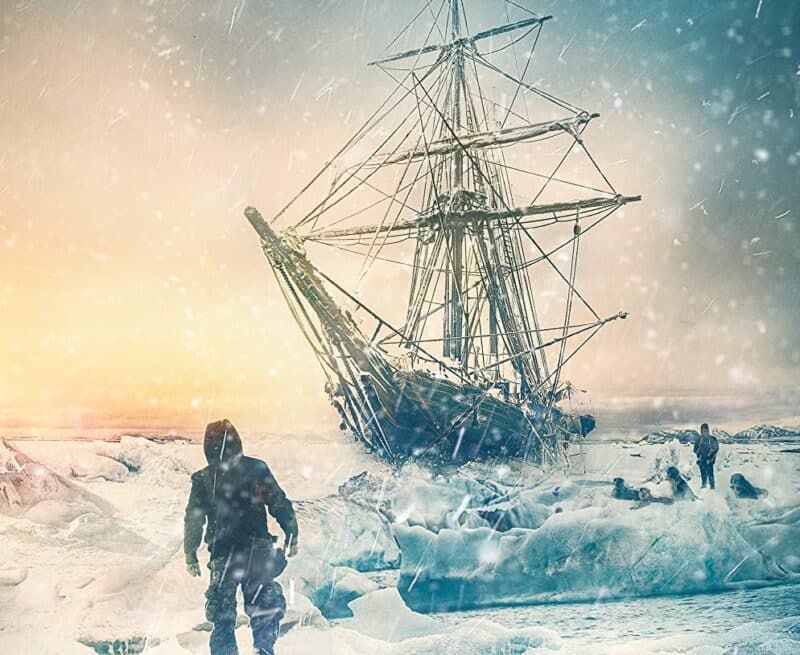Few tales from the heroic age of Antarctic exploration have been studied as closely as the Imperial Trans-Atlantic Expedition led by Sir Ernest Shackleton between 1914 and 1917. Thanks to having Australian explorer-photographer Frank Hurley among the 28-strong party, a permanent pictorial record exists. This was complemented by his diaries as well as written accounts by Shackleton and others.
South: Sir Ernest Shackleton’s Glorious Epic of the Antarctic, an 88-minute documentary, was first released in 1919, and was remastered by the British Film Institute for cinema release in 2022. One screening in London featured a live performance by the Covent Garden Sinfonia. It is considered the world’s first documentary feature.
The ill-fated expedition has produced a mini-library of books, which range across the spectrum from those aimed at children to texts on management and leadership.
Among the movies, George Butler produced two documentaries using Hurley’s footage to replicate parts of the expedition: The Endurance: Shackleton’s Legendary Expedition (2000) and a 40-minute version for IMAX, Shackleton’s Antarctic Adventure (2001).
The former was based on Caroline Alexander’s book, while the latter features interviews with other explorers and mountaineers, including Reinhold Messner.
A year later, Kenneth Branagh played Shackleton in a two-part British TV series, simply called Shackleton, and filmed in the UK, Iceland, and Greenland. An earlier four-part series was made in 1983 covering all four of Shackleton’s expeditions.
In 2012, New Zealand documentary maker Leanne Pooley produced Shackleton’s Captain, which focused on Akaroa farmer Frank Worsley, who captained Endurance. It was also based on a book, by John Thomson, and used a combination of dramatised scenes, interviews, and Hurley’s photographic archive.
The latest to join these is an Australian production, Shackleton: The Greatest Story of Survival (Kismet), which combines Hurley’s and Burler’s material with a recreation led by environmental scientist author and adventurer Tim Jarvis.
Shackleton’s expedition aimed to cross Antarctica by foot with dog sleds from the Weddell Sea to the Ross Sea. But their ship became trapped in ice for nine months before it could make landfall at the starting point, Vahsel Bay.
The ship drifted north in the ice and was eventually crushed beyond repair, forcing the expedition to use lifeboats to reach Elephant Island. All survived this journey, but Shackleton selected only five to travel with him in a lifeboat to South Georgia, where they could organise a rescue.
Jarvis built a replica of the lifeboat to repeat this epic trip of some 800 miles (1300km) in open sea in sub-zero conditions. The landing on South Georgia then required a trek through unmapped snow-covered mountains and glaciers to reach the whaling station.
Jarvis’s crew performs this feat as well, though the comparisons with Hurley’s time shows a considerably changed landscape, thanks to global warming. It is in these scenes that Jarvis adds value to Shackleton’s already acknowledged leadership qualities that allowed all men to be rescued alive.
Rating: Parental guidance advised. 91 minutes.
CLIPS
Air
(Amazon Studios)
Ben Affleck and Matt Damon are back as a team in this adrenalin-fuelled story of how sports shoe company Nike pursued basketball star Michael Jordan in 1984 to endorse what became the world’s most coveted sneaker, the Air Jordan. Affleck is also behind the camera as director, again demonstrating his ability to keep a story moving (Gone Baby Gone, Argo). It helps that the mix of business and sport has produced some great movies, such as Jerry Maguire, Money Ball, and Million Dollar Arm. Affleck plays the eccentric co-founder and onetime chief executive of Nike, Steven Knight, while Damon is Nike’s hustling recruitment agent. The rest of the cast are also first rate, from Jason Bateman as the marketing man to Chris Messina as Jordan’s agent, and Viola Davis as the proud and protective mum. The original screenplay is by Alex Convery.
Rating: Mature audiences 112 minutes.
John Wick: Chapter 4
(Studio Canal)
The latest episode in a saga that has proven box office gold demonstrates that a movie comprising mainly action scenes can rise to the occasion. Director Chad Stahelski, this time aided by writers Shay Hatten and Michael Finch, has honed the formula into a slick brand that makes the hitman hero (Keanu Reeves) as distinctive as James Bond, including attempts to kill him off as a character. Although this has resulted in the longest effort yet, the combat choreography is as uncomplicated as the plot and free of distractions. Like Bond, Wick is also a globetrotter as he eludes hordes of assassins in locations that include New York, Osaka, Berlin, and Paris. The Wick series set a new level for set piece action. It also widened its appeal to provide some arty cinematography that wowed even those inured by endless gunfights.
Rating: R16. 169 minutes.
Aftersun
(Rialto Distribution)
A father (Paul Mescal) and his 11-year-old daughter (Frankie Corio) spend a summer at a cheap beach resort on Turkey’s southern coast in late 1990s. She records the holiday with her video camera, with an emphasis on what those older than her are enjoying. This contrasts with the father’s attempt to put on a brave face while coming to terms with a marriage breakup. He even confesses his doubts about his future to a swimming instructor. Writer-director Charlotte Wells, in a debut feature, takes a minimalist approach that requires the viewer to empathise with the differing attitudes of her characters in a story that has autobiographical overtones.
Rating: Mature audiences. 102 minutes.

Reader Interactions